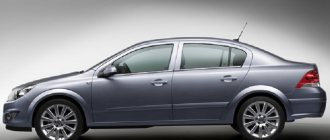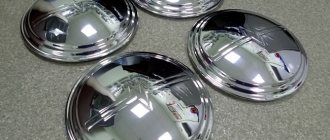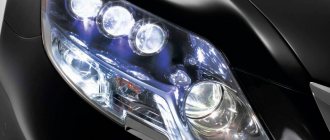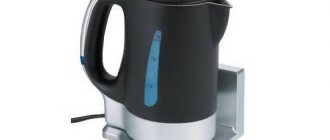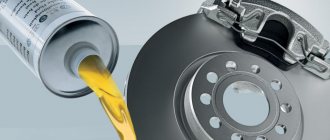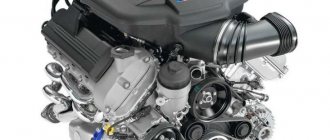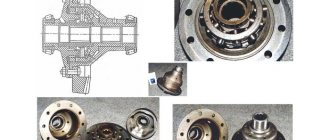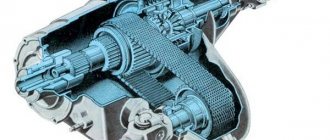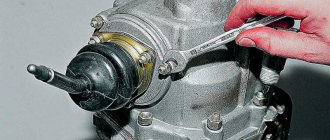The rear drive axle contains a differential.
Differential
(from Latin differentia - difference, difference) - a mechanism in the transmissions of transport and (less often) technological machines for transmitting power through rotation with the simultaneous division of a single power flow into two differentially connected ones or the summation of two independent power flows into one. The peculiarity of the differential and the meaning of its term is that this mechanism produces the division/summation of power flows precisely differentially: each of the two outgoing/incoming flows can at any time receive/give from 0 to 100% of the power relative to the single input/output (adjusted on the efficiency of the differential), and the ratio of these powers to each other can be any within this 100%.
In its canonical purely mechanical form, it is a planetary gear, consisting of one simple three-link flat or spatial planetary mechanism without any control elements (brakes or clutches). Actual differentials, based on their tasks in the transmission, can be supplemented with planetary gears and control elements. However, recently, purely frictional devices that perform the functions of a differential - viscous couplings - have become widespread.
Unlike power and angular speed of rotation, torque is divided rigidly and invariably by the differential. Hence such terms as symmetrical differential (moment is divided in a ratio of 50/50) or asymmetrical (moment is divided in any unequal ratios). When summing, the torques on the differential also add up according to certain principles.
From a mechanical point of view, any differential has two and only two degrees of freedom. A mechanism that performs the functions of a differential and has three degrees of freedom is more correctly called a double differential (four - triple, and so on).
Content
- 1 Purpose
- 2 Device
- 3 Location
- 4 The problem of a slipping wheel
- 5 History of ways to solve the problem of a slipping wheel
- 6 Self-locking differential
- 7 Forced locking differentials 7.1 Manual differential lock
- 7.2 Electronic differential control
- 7.3 DPS
Purpose
The need to use a differential in the drive design of automobiles is due to the fact that when turning, the outer wheel travels a longer arc than the inner one. That is, when the drive wheels rotate at the same speed, turning is only possible with slipping, and this negatively affects handling and greatly increases tire wear.
Purpose of differential in cars:
- allows the drive wheels to rotate at different angular speeds;
- continuously transmits torque from the engine to the drive wheels;
With a single drive wheel or a separate motor for each drive wheel, a differential is not required. In the design of rally cars, sometimes the differential is tightly locked (welded), rigidly connecting the wheels of the drive axle - this is acceptable, since on gravel or snow in rally corners can only be skidded. Also, there is no differential in the design of karts, while the flexibility of their frames usually allows the driving rear wheel to hang out on the inside of the turn without lifting the front wheels off the track. In velomobiles with a drive axle, instead of a differential, simpler and more accessible ratchets (overrunning clutches) in the wheels are often used - such a drive allows the wheels to rotate on the drive axle at different speeds, but at the same time, all the torque is transmitted only to the wheel that rotates more slowly.
Functions of the differential device of the Niva Chevrolet
By automobile differential, experts mean a mechanical installation that includes a set of planetary gears and shafts. The functions of the Chevrolet Niva differential include the distribution of torque from the internal combustion engine of the vehicle to the drive wheels mounted on the same axle. Thanks to this, the car's wheels spin at different speeds.
The ability of the Chevrolet Niva wheels to spin at different speeds is very important when making turning movements. Especially when one wheel runs along a small radius, and the second wheel, located on the same axis, runs along a large radius. If there were no such device as an inter-wheel differential device, the vehicle's wheels would slip.
As a result of such spinning, the car would skid to the side, and the tires would wear out faster and lose their functional features.
When a Chevrolet Niva moves along a straight road at a constant speed, the inter-wheel differential device distributes the thrust from the internal combustion engine evenly between all wheels. This means that both driving wheels will rotate at the same speed. If any drive wheel slips, the differential will increase the traction force on the slipping wheel. As a standard, a passenger car is equipped with one cross-axle differential on the drive axle. There are three such devices for the Chevrolet Niva; they are installed on:
- front axle;
- rear axle;
- at the center of the interaxial action.
A central differential device is needed to distribute the torque to both axles of the vehicle from the internal combustion engine.
Device
The basis of any differential can only be a planetary gear, which, due to the mechanics of its operation, is the only one of all rotational motion gears that can solve the problems facing a differential in a transmission. The term “planetary differential” is redundant - any differential is planetary. The performance of the PP as a differential absolutely does not depend on its composition or shape, or on the choice of specific links for driving or driven. Any PP in its simplest version - a three-link planetary mechanism without any control elements - can perform the functions of decomposing one flow into two interconnected ones or adding two independent flows into one. The choice of other PP links as leading ones, and others as driven ones, is determined only by the required kinematics of the differential’s connections with other transmission elements and the peculiarities of the mechanics of the differential operation in the chosen format of distribution of functions between the links. The addition of control elements to the PP and the use of so-called complex planetary mechanisms gives the differential the ability to mutually equalize the angular velocities of flows and the ability to actively control these velocities.
Sectional view of the differential of a Porsche Cayenne
The canonical, most famous type of differential is the cross-axle differential of a car, made on the basis of a simple (that is, three-link) spatial planetary mechanism of the SHS circuit on four bevel gears. The planetary carrier of such a differential actually serves as its entire body - this is the driving link ➁. The two gears are satellites on a common axis ➂. And the two gears are two suns - two driven links ➃. Power is supplied to the housing (carrier) through a rigidly fixed driven gear of the main transmission, which in turn is paired with the drive gear ➀ formally there is another element of the transmission, despite the fact that the differential with the driven gear often looks like a single assembly unit. Power is removed from two suns, to which in this case shafts with CV joints are attached.
Location
On vehicles with a single drive axle, the differential is located on the drive axle.
Tandem axle vehicles have two differentials, one on each axle.
On vehicles with all-wheel drive, there is one differential on each axle. It is not recommended to drive such vehicles on hard-paved roads with all-wheel drive engaged.
On cars with permanent all-wheel drive, there are three differentials: one on each axle (axle-axle), plus one that distributes torque between the axles (axle-axle).
With three or four driving axles (wheel arrangement 6 × 6 or 8 × 8), an inter-vehicle differential is also added.
What is the purpose of blocking?
A cross-wheel differential is a mechanism that ensures the wheels of one axle rotate at different frequencies . It is installed in the drive section of the drive wheel shafts, and on vehicles with all-wheel drive - on both axles. The differential finds its main application when cornering - since the wheels of one axle travel different distances during a turn, the differential ensures vehicle stability and eliminates the parasitic circulation of power when cornering.
A center differential is used on vehicles with two or more drive axles . It ensures that the torque coming from the propeller shaft is divided into two independent streams. Another function of the unit is to ensure stability when a four-wheel drive vehicle corners.
However, a working differential can create difficulties off-road . If one wheel of the car is suspended and does not have contact with the road, and the second wheel of the axle is on a hard surface, then the operation of the differential ensures the rotation of the suspended wheel.
A similar problem can be solved by forced differential locking. It allows you to equalize the ratio of the incoming torque to all four wheels, and therefore equalize the sum of the rotation speeds of the wheels of the front and rear axles. If one of the wheels is suspended or slips, then the maximum torque will be transmitted to the wheels that have maximum rotation resistance. By transmitting more torque to wheels that have traction with the surface, the blocking increases cross-country ability and allows you to overcome off-road conditions.
The problem of a slipping wheel
A conventional ("free") differential works fine as long as the drive wheels are inextricably connected to the road. But when one of the wheels loses traction (finds itself in the air or on ice), then it is this wheel that rotates, while the other, standing on solid ground, is motionless. If one of the wheels loses traction, its resistance to rotation drops, and rotation occurs without a significant increase in the moment of resistance (sliding friction in the contact patch is less than static friction and does not significantly depend on the slipping speed). At the moment when the wheel begins to slip, the torques on the wheels are not equal to each other, but are inversely proportional to the resistance to rotation of the wheels.
When the car moves in a straight line, the satellites do not rotate relative to their own axis. But each, like an equal-arm lever, divides the torque of the main drive driven gear equally between the axle gears. When a car moves along a curved path, the inner wheel with respect to the center of the circle described by the car rotates more slowly, the outer wheel rotates faster - while the satellites rotate around their axis, running around the gears of the axle shafts. But the principle of dividing the torque equally between the wheels remains the same. The power supplied to the wheels is redistributed, because it is equal to the product of the torque and the angular velocity of the wheel. If the turning radius is so tight that the inside wheel stops, then the outside wheel rotates at twice the speed as when the car is moving in a straight line. So, the differential does not change the torque, but redistributes the power between the wheels. The latter is always larger on the wheel that rotates faster.
What is a partial differential lock?
Partial differential locking means a limited amount of transmitted force among the parts of the differential and an increase in torque on the wheel that has the best grip.
The increase in torque at the free wheel is called the locking ratio. That is, it displays the relationship between the torque on an unloaded wheel and the wheel that runs, that is, slips. The locking coefficient of a symmetrical free differential will be equal to -1, since the torque of each wheel will be the same. While on a locked differential this value can vary in the range from 3 to 5. Any further increase in this locking coefficient is highly undesirable, since it can cause failure of the transmission or some of its parts.
Both cross-axle and center differentials use differential locks. In order not to reduce controllability, the front cross-axle differential is not locked in all-wheel drive vehicles.
Engaging the differential lock can be forced or fully automatic. In the case of forced, the driver chooses when to engage the differential lock; sometimes it is also called manual.
As for automatic locking, its activation is carried out using special technical devices - so-called self-locking differentials.
History of ways to solve the problem of a slipping wheel
- 1825 - Onesiphore Pecqueur (1792-1852)
invented the differential. - 1932 - Ferdinand Porsche began research into slip differentials.
- 1935 - collaborating with Porsche, launched a cam differential, which was subsequently used on early Volkswagen models (Type B-70)[1]
- 1956 - the American company Packard was one of the first to begin producing models with an LSD differential under the brand name “Twin Traction”. In the 60s, many companies began producing LSD differentials under various brand names:
- Alfa Romeo: Q2
- American Motors: Twin-Grip
- Buick: Positive Traction
- Cadillac: Controlled
- Chevrolet/GMC: Positraction
- Chrysler: Sure Grip
- Dana Corporation:Trak-Lok or Powr-Lok
- Ferrari: E-Diff
- Fiat: Viscodrive
- Ford: Equa-Lock and Traction-Lok
- International: Trak-Lok or Power-Lok
- Jeep: Trac-Lok (clutch-type mechanical), Tru-Lok (gear-type mechanical), and Vari-Lok (gerotor pump), Power Lok
- Oldsmobile: Anti-Spin
- Pontiac: Safe-T-Track
- Porsche: PSD (electro-hydraulic mechanical)
- Saab: Saab XWD eLSD
- Studebaker-Packard Corporation: Twin Traction
Self-locking differential
Main article: Limited differential
The term refers to any differential whose operating mechanics allow it to self-lock—that is, first of all, to equalize the angular speeds of the driven gears and turn into a direct transmission. Self-locking differentials do not require any external control systems and operate autonomously. In cars they can be used both as inter-wheel and inter-axle ones. They are not used in tracked vehicles. Conventionally, all “self-blocks” can be divided into two groups: those triggered by torque and those triggered by the difference in angular speeds on the driven gears. The first group includes differentials with screw, worm and disc locks. The second category includes differentials with viscous couplings, differentials with a gerotor pump, differentials with a centrifugal automatic engagement device (Eaton G80), differentials with overrunning clutches (Ferguson). Designs such as cam differentials and Krasikov/Nesterov differentials can probably be considered something intermediate in the context of locking actuation principles.
Why do you need an imitation differential lock?
Simulated differential lock, or EDS (Elektronische Differenzialsperre) for short, makes the vehicle much easier to control and improves its dynamics. It simulates differential locking and is based on ABS. Using this mechanism, you can avoid slipping of the drive wheels on a slippery road, when entering a turn or when starting to move. EDS is also successfully used in relatively off-road conditions with diagonal suspension.
The electronic locking simulator system is currently present in many cars, but may differ in name.
- EDS - electronic differential lock. This mechanism is included in most modern cars;
- ETS (Electronic Traction System) - developed by the German company Mercedes-Benz. This well-known company has also developed a new 4-ETS system, which has the ability to brake all wheels of the car;
- XDS is a more advanced version of EDS, developed by the automaker Volkswagen. XDS significantly improves the movement of vehicles during cornering by braking the wheel that moves on the inside radius.
Forced locking differentials
Manual differential lock
Forced locking differential
Upon command from the cab, the differential gears are locked and the wheels rotate synchronously. Thus, the differential should be locked before overcoming difficult sections of the road (sticky soil, obstacles), and then unlocked after entering a regular road. Used in all-terrain vehicles and SUVs.
When driving such cars, it is most often not recommended to lock the differential when the car is moving; it is advisable to turn on the lock when parked. You also need to know that the torque generated by the motor is so great that it can break the locking mechanism or the axle shaft. Typically, car manufacturers separately indicate the recommended maximum speed when the differential is locked; if it is exceeded, transmission breakdowns may occur. Engaged locking, especially on the front axle, negatively affects handling.
Electronic differential control
On SUVs equipped with a traction control system (TRC and others), if one of the wheels slips, it is slowed down by the service brake.
A similar solution was applied in Formula 1 in 1998. In the McLaren MP4/13 car of the McLaren team, when turning, the driver could slow down the inside wheel with the service brake. This system was quickly banned, but in Formula 1 the design of the friction differential, in which the clutch is additionally controlled by a computer, has taken root. In 2002, technical regulations were tightened; from the same year (2002) to this day, only differentials of the simplest type are allowed in Formula 1.
The advantage of electronic control is that cornering traction is increased and the amount of lock-up can be adjusted depending on driver preference. On a straight line there is no loss of engine power at all. The disadvantage is that the sensors and actuators have some inertia, and such a differential is not sensitive to rapidly changing road conditions.
DPS
Main article: DPS
Dual Pump System - a system with two pumps that automatically connects the second axle when one is not enough. Used in Honda all-wheel drive systems. Advantages: works automatically, saves gasoline on good roads. Disadvantages: limited cross-country ability, complexity, towing restrictions.
Cross-axle differential locks
Many car enthusiasts have heard about the benefits of car locks. We'll tell you about the main types of cross-axle differential locks on a car and how they work.
Forced blocking
ARB Air Locker is a force-locked locker and in its normal state represents a regular classic differential.
When such a differential is engaged (locked), the axle shafts of the locked axle are locked together rigidly - therefore, locks of this type are usually called hard, or 100% locks. The ARB system has the main advantage: having the softness of a conventional differential on hard surfaces, it nevertheless achieves complete locking at the right time.
The disadvantages of ARB are its high cost, complexity of installation and skill in using it. If you forget to turn off the lock on a paved road, you can break the transmission or lose control. In addition, hard locks place high demands on the car - when installing oversized wheels on lifted cars, axle shafts, cardan joints and other transmission parts can tear.
ARB is not the simplest system to design. It includes a lot of components, which reduces reliability. For example, a compressor may burn out, and if the generator fails, the battery will not last long, and therefore the compressor motor will not function, and the electrical wire may break.
Without differential bridge
Strictly speaking, this type of blocking is a drum installed instead of the differential box, on which the driven gear of the main gear is mounted and the axle shafts are inserted, that is, the right and left axle shafts are constantly interlocked with each other.
There is thus no differential. Such a system has no right to life in the front axle - it is impossible to drive a car, but on rear drive axles, for example, such a mechanism is used more often than a conventional cross-axle differential. Disadvantages: rapid wear of tires on paved roads, high loads on the transmission, poor handling. Advantages: simplicity and reliability.
Automatic lock Detroit Locker
The most famous type of automatic blocking. It is installed in place of the factory differential housing, which increases the strength of the entire assembly. Detroit Locker requires no wires or lines to turn on, no buttons to press or levers to operate—it just happens automatically. The minimum number of internal parts ensures high reliability of the unit. All modifications of the Detroit Locker feature a cam lock, reminiscent of the design installed on the GAZ-66. It is distinguished by its simplicity, reliability in use and mediocre performance on hard surfaces, which affects handling, especially when used on the front axle, which accelerates tire wear. Some discomfort is caused by clicks and metallic impacts heard when this lock is operating.
Gov Lock
In normal condition it represents a classic open differential. As soon as the rotation speed of one axle wheel relative to the other reaches a certain value - approximately 2 revolutions per second - the centrifugal contactor snaps into place the dog clutch, which clamps the clutch pack, and the faster the slipping wheel rotates, the stronger it is. Thus, Gov-Lock has a progressive blocking characteristic - from zero to one hundred percent.
This device has a device that automatically turns off the lock when the machine reaches a speed of 40 km/h. It has virtually no negative impact on handling.
- Dictionary for jeepers - all unclear terms
There are disadvantages: a large number of small parts causes a high probability of breakdowns, which is what happens in practice - the contactor gear breaks and the lock stops working.
In addition, Gov Lock does not always work effectively. If the car is stuck in soft ground, then this blocking can aggravate the situation. After all, to turn it on, you need to strongly spin the slipping wheels, which will lead to the instant burying of the jeep, and the locker that turns on at the end will only aggravate the situation, finally landing the SUV.
Limited Slip Differential (LSD)
The most common type of limited slip differential is the “disc” differential.
This type of locking is used on most SUVs. It operates softly and causes virtually no harm to the transmission. It should be remembered that LSDs have a low blocking coefficient (about 30%), and as a result are not effective enough in difficult conditions. Such locks do not work when one of the wheels is hanging out , when the help of a locker is required. There are friction disc packages that provide greater locking rates, but they still do not provide 100% locking. In addition, as it increases, the load on the transmission when driving on hard surfaces also increases.
The downside is the limited resource. Friction discs tend to wear out, and the more often the wheels slip, the more the discs wear out. If such a differential is installed in the rear axle of a car that is not intended for constant movement with all-wheel drive (Part time only), then in winter in city conditions it has to work a lot, since the rear axle will slip quite often.
In general, the resource of this blocking ranges from 50 to 150,000 km. It does not fail immediately, but “dies” gradually, reducing the blocking coefficient. It must be remembered that limited slip differentials require the use of special additives for the oil that is poured into it.
Active differential
The term means any differential, the device of which allows you to redistribute power/traction on the driven links in any proportion required for a given moment of movement. This is precisely the difference between an active differential and a locked one, in which power control on the driven links is in principle impossible, and it is determined solely by the clutch forces. All active differentials have a two-channel control system and necessarily two control elements - two brakes or two clutches - that are activated upon command from external sources. All active differentials, in addition to the main planetary gear, which performs the functions of free power distribution, have a paired set of additional planetary or simple gears, which perform the function of redistributing power in their direction. Each of these paired gears is associated with its own control element. Although active differentials do not have any locking mechanisms, in fact, all active differentials are also lockable, only they do not have one symmetrical locking mode, but two asymmetrical locking modes (one for each of the two sides). In these modes, the differential control element operates without internal slipping, and the differential itself turns into an overdrive gear. On passenger cars with active differentials, these extreme modes may not be used, but they are used in the differential turning mechanisms of tracked vehicles.
Cases of lack of differentials in the transmission
The presence of differentials dividing power in the transmission of a transport vehicle is not necessary. Their absence undoubtedly leads to increased loads on the transmission and increased wear of the wheels, but this is either tolerated or is not important in terms of the intended operation of a particular machine. A four-wheeled car with two driven wheels can in principle do without a differential - for example, a go-kart, or a racing car with a rear driven axle for racing on low-traction surfaces. In extra cases, there may be no differential even on an asphalt racing car (for example, the winner of the 1991 24 Hours of Le Mans Mazda 787B). On a purely front-wheel drive car, a cross-axle differential must be present, since its absence will not allow adequate turning, regardless of the type of road surface. All-wheel drive vehicles may not have center differentials, but again, either this is unimportant in terms of the operation of the vehicle (for example, WRC racing cars from 2012-2016), or driving such a vehicle is only allowed on surfaces with a low coefficient of adhesion (for example, SUVs with connected front axle like UAZ-469 or Jeep Wrangler). There are no differentials on traction machines of railway transport - electric locomotives, diesel locomotives, electric trains, subway cars. The wheels of one axle of these machines, due to the conical surface of the rolling circle and increasing the track width on the arc, can be shifted slightly to the side from the center of the track and thereby provide different diameters at the points of contact of the wheel with the rail. Plus, the wheels can slip when moving in an arc, making a specific sound, which is partly offset by the inclination of the rail bed in curves. Individual turning mechanisms of tracked vehicles can also do without differentials in their design - here the movement of the machine along an arc is determined either by slipping of the friction clutches, or in general the machine has only a few fixed turning radii. There are no differentials in velomobiles, where instead, for the sake of cost and simplicity, simpler and more accessible ratchets (overrunning clutches) are used in the wheels - such a drive allows the wheels to rotate on the drive axle at different speeds, but in this case, traction is transmitted only to the wheel that rotates more slowly . Differentials may not be present in walk-behind tractors and small-scale mechanization equipment, where their absence is offset by the extremely narrow track of the drive axle wheels, easily deformable tires, and the low coefficient of adhesion between the wheels and the ground.
